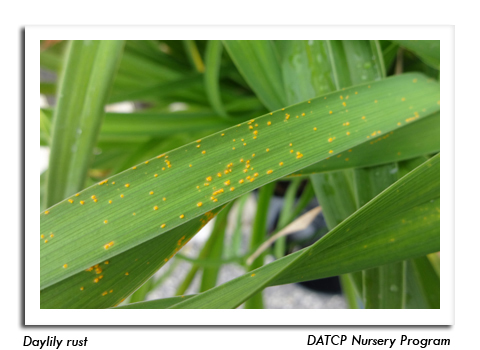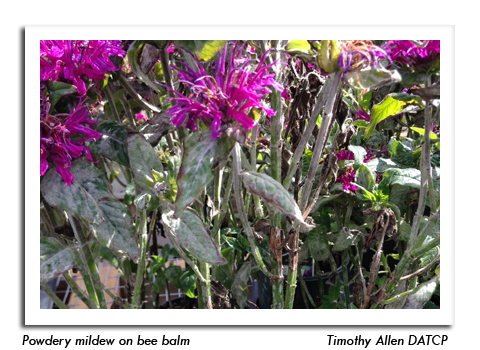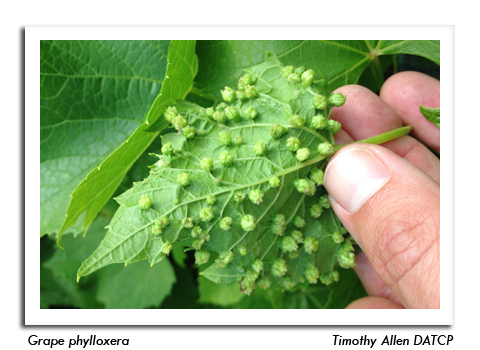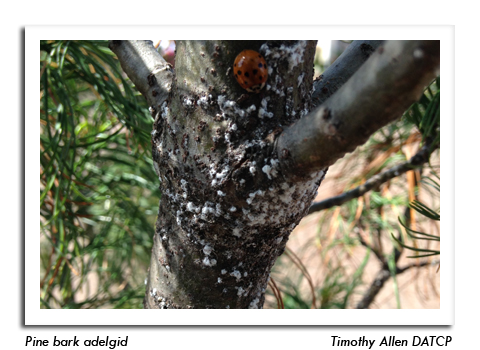
 |
|
|
Nursery & Forest
Volume 62 Number 12 Date 07/20/2017 DAYLILY RUST - Daylily plants in a Milwaukee County nursery were infected with this rust disease. Symptoms include small, raised yellowish-orange pustules that appear on the lower leaf surface and eventually release spores that spread to other daylilies. The disease cycle involves a secondary host, Patrina spp. Daylily rust is not known to overwinter in Wisconsin. The spores either arrive on southerly winds or on infected plants from out-of-state suppliers. CALLIGRAPHA LEAF BEETLE - These ornately-marked beetles were found on ninebark and snowball viburnum in Crawford and St. Croix counties. Beetles in the genus Calligrapha are known to defoliate spiraea, ninebark, and Ribes. Healthy, established shrubs can tolerate significant leaf feeding, even complete defoliation. Shrubs that are already severely defoliated should not be treated. BLACK SWALLOWTAIL - Nursery inspectors observed larvae of the black swallowtail butterfly on fennel earlier this week. These beneficial pollinators feed on a variety of plants in the parsley family. Two broods occur in Wisconsin, one in early May and another in late July. The adult butterflies are commonly seen in August. POWDERY MILDEW - Bee balm plants in a Price County nursery were infected with this common fungal disease. Powdery mildew is characterized and easily diagnosed on most plants by a grayish white powdery dusting on the upper leaves, which causes foliage to turn yellow and senesce prematurely. Cultural practices that increase air circulation usually reduce mildew development. MALLOW SAWFLY - Light to moderate damage to glade mallow plants caused by this sawfly species was noted in a St. Croix County nursery the past week. The larvae, which have black heads and green bodies, feed on the underside of hibiscus, hollyhock, and other ornamentals in the rose mallow family. The mallow sawfly is considered a minor pest and its feeding should be tolerated. -- Shanon Hankin, Marcia Wensing, Konnie Jerabek, DATCP Nursery Inspectors GENETIC REVERSION - The phenomenon of genetic reversion was recently observed by a DATCP inspector on Alberta spruce in Marathon County. According to the report, the affected Alberta spruce had vigorous growth of white spruce tree emerging from the midsection, and essentially appeared to have another tree growing from it. Genetic reversion occurs when trees or shrub cultivars produced from a genetic mutation (commonly dwarf evergreens) revert to their natural, non-mutated form. In the case of Alberta spruce, the original form is the white spruce. Reversion is also common in variegated Norway maples. When reversion occurs, the rapidly-growing portion should be pruned out immediately. If left un-pruned, reversions will dominate the tree and the homeowner who purchased a dwarf Alberta spruce or variegated maple will be left with a white spruce or Norway maple. GRAPE PHYLLOXERA - Galls of this common foliar insect pest of grapes were observed at a nursery facility in Price County last week. Grape phylloxera is tiny, yellowish aphid-that produces unattractive leaf galls which reduce the photosynthetic surface area. Nursery managers and grape growers concerned about the appearance of phylloxera galls on grape foliage are reminded that insecticide treatments should have been applied at the first sign of gall formation in late May or early June. Control is ineffective once the galls have formed. PINE BARK ADELGID - The white cottony egg masses laid by female adelgids were observed on the bark, branches and trunks of 'Twisted' eastern white pine trees at a nursery in Price County. The infestation was not severe, but pine bark adelgids can coat the surface of trees, stunting growth and causing needles to turn black from sooty mold. Tree death is rare and usually impacts older trees. Smaller trees are generally not attacked. Dormant oils may be applied in fall or spring to kill the nymphs. Pine bark adelgid also occurs on Austrian and Scots pine. -- Timothy Allen, DATCP Nursery Inspector 





|
|
|